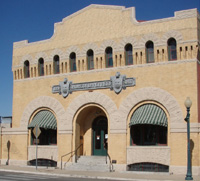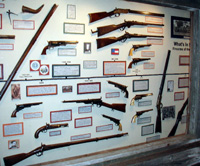Getting
Out There: |
Directory of all "Getting Out There" Articles> |
|
Page
1 | 2
|
| Aaron Reed takes a Saturday road trip up the Mexico-Canada corridor and back in time as he explores the roadside attractions of Waco, Texas. Here, in the shadow of Baylor University, the frontier meets free enterprise. |
|
It is a cool morning and Tamara and I are bound
for Waco. The worst part is the first part: a long slog on
Interstate Highway 35 in the company of Canada-bound NAFTA
truckers, soccer moms struggling to get across town, and Saturday
shoppers headed for the strip malls.
It's the most congested stretch of the entire 1,700-mile highway.
North Austin itself has become a vast retail wasteland, as
unlovely a vision of modern America as one is likely to see.
The pretty parts and interesting bits -- like Georgetown's
inviting city park and its historic courthouse square -- are
mostly tucked well away from the highway frontage roads.
After we clear the northern edge of the metro area, we drive
north through sparsely populated farmland and ranchland and
rolling hills covered in stunted, scrubby trees. This is workaday
Texas, the part of Texas that looks like much of the American
heartland.
It does not move me as it once did.
I tell Tamara of another trip on this road, one I took shortly
after the conclusion of the first Gulf War. I had been living
in northern Virginia and had flown back for a friend's wedding.
I'd been gone for a year -- the longest time, until then,
I had lived outside my native state. As the highway unrolled
before me, I took in the rolling hills and round bales of
hay and scraggly sumac and cedar and the vast, low, gray sky
and -- all of a sudden -- missed Texas. I resolved to move
back at the first opportunity.
That same day, as if to confirm the end of my apostasy, I
walked into a truck stop near Hillsboro and found Willie Nelson
drinking coffee after an all-night game of dominoes.
"Mr. Nelson?" I asked, shyly -- it didn't seem right
to call the red-headed stranger by his first name. "Can
I get your autograph?"
This day we are headed to Waco to learn what we can of two
other legendary Texas institutions: the Texas Rangers, the
state's storied frontier lawmen, and Dr Pepper, my lifelong
favorite soft drink.
Though perhaps better known for the tragic 1993 siege at the nearby Branch Davidian compound, or as home to Baylor University and the Southern Baptist Convention, Waco is also a city of neighborhoods, with elegant bridges spanning the Brazos River; a small, world-class zoo; and a business district that has some buildings of architectural interest.
We take exit 335B to the east side of the city
just before the interstate crosses the river, and then head
straight for the Texas Ranger Hall of Fame.
|
Texas Ranger Hall of Fame and Museum
My first visit to the museum was in the mid-1970s. Back then,
I was still playing "Cowboys and Indians" with my
Texas playmates, and I remember thinking the museum was pretty
darned cool.
Today the Texas
Ranger Hall of Fame and Museum is operated by the City
of Waco. Six bucks at the front desk buys entry into an extensive
and fascinating collection of firearms, a pretty fair display
of Western art and a few interesting photos.
My eyes glazed over before we reached the second
room, and that's too bad, because the legendary Texas lawmen
deserve their due. Rangers served Texas from colonial times,
and still serve as the elite investigative division of the
Texas Department of Public Safety, which includes the state's
ubiquitous highway patrol.
In the old days, Rangers pursued border bandits and cattle
rustlers and gained fame as frontier surveyors and Indian
fighters. Later, their targets were bootleggers and oil-boom
vice. They were so respected -- or perhaps feared -- that
a slogan was coined: "One riot, one Ranger."
I remember thinking of that legendary tagline as I watched news coverage of the surrender of Rafael Resendez-Ramirez in 1999. A Mexican national suspected in a killing spree across Texas, Illinois and Kentucky, Resendez-Ramirez made the FBI's "10 Most Wanted" list before walking across the international bridge from Juarez, Mexico, to El Paso, Texas, and extending his hand to a single Texas Ranger. Sgt. Drew Carter, who had negotiated Resendez-Ramirez's surrender, shook the man's hand, and then placed him in cuffs.
But that story, so far as I could tell, is not told in the Waco museum. Also absent is any real attempt to unravel the complexities of law enforcement on the border in the late 19th century and early 20th century or to examine the Texas Rangers' sometimes less-than-noble role in the troubles.
The storytelling here is more glorifying, and more vacuous. One placard notes that before 1880, the Rangers did not wear badges, as their authority was not recognized. Another notes that Rangers sometimes had to employ brutal tactics, but implies that the brutality was justified by its effectiveness. I saw no mention of the hundreds - perhaps thousands -- of Mexican nationals and Mexican-American "Tejanos" killed by Rangers patrolling the border during the Mexican Revolution, or of the vigilante justice the Rangers often employed. Perhaps the museum's 45-minute video presentation touches on these themes, but I rather doubt it.
The final display, tucked into a gallery near
the gift shop, is a presentation of Texas Rangers and popular
culture. It includes genuine derivations, like a G.I. Joe
"Texas Ranger" action figure, along with some completely
unrelated items like a model of a Bell "Jet Ranger"
helicopter and a collection of "Power Ranger" cartoon
figures.
Struggling to make sense of the presentation, and numbed by
the sheer number of guns on display, Tamara and I begin to
feel a bit edgy. And hungry. We get back into the car for
a quick jaunt south to the Valley Mills Drive exit and Waco's
famous traffic circle.
Continued
on page 2>
11/2/07


